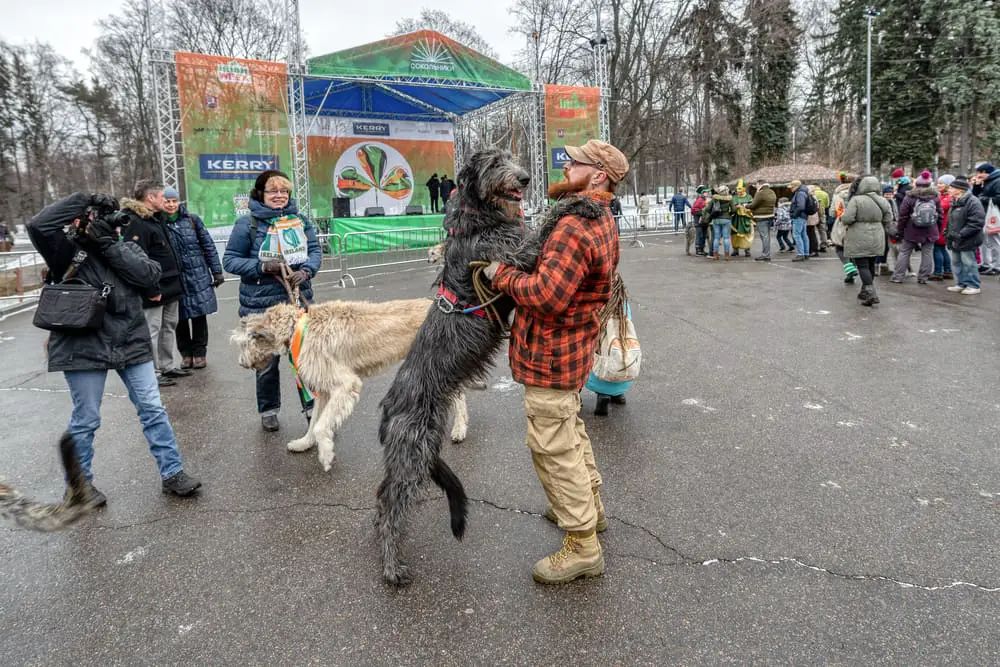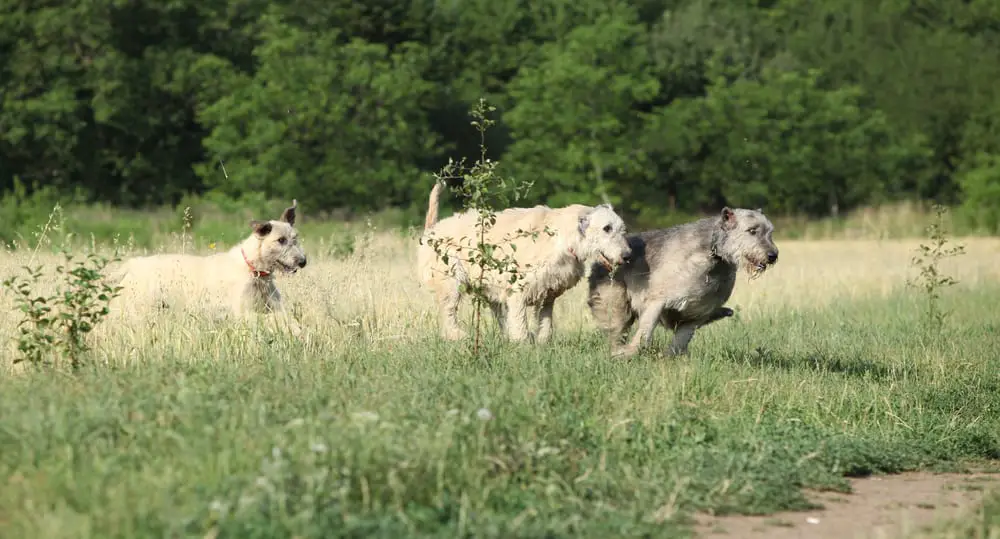Complete Guide To The Irish Wolfhound: Care, Feeding, Grooming and More
Irish Wolfhounds may look like lanky teenagers, but they’re remarkably strong and graceful. Fast, friendly and fearless, their quiet courage and gentle nature make them superb companions.
I’ve known only a handful of Irish Wolfhounds in my 20+ year career as a veterinarian, and they all were gentle giants that unfortunately didn’t live as long as their owners had wanted. Nevertheless these are magnificent dogs for the educated owner.

Table of Contents
How Big Do Irish Wolfhounds?
| Height | Weight | |
| Male | 32″ at the shoulder – minimum | 120 lbs |
| Female | 30″ at the shoulder – minimum | 105 lbs |
In my personal experience, the dogs that I’ve seen have been larger than this.
What Colors Do Irish Wolfhounds Come In?
Some of the colors you may see include:
| Black | Blue | Gray | Cream |
| Red | Silver | White | Wheat |
Their long muzzles and disproportionately small ears are similar to a Greyhound’s, but they sport a stockier frame. With muscular hindquarters built for speed — Irish Wolfhounds don’t run, they gallop.
Bred to hunt wolves, they’re distinctive among dogs but are often mistaken for the smaller Scottish Deerhound.
What Is The Personality of A Irish Wolfhound?
The Irish Wolfhound’s sheer size belies its serene spirit. Devoted to their families, they crave human companionship but are too placid to be guard dogs. They’re trustworthy with children but don’t know their own strength, so supervision is a must with little ones — early socialization and training is essential.
Today, these once-ferocious big-game hunters would rather cuddle than catch prey, but they’re still fond of the chase and need plenty of exercise, so apartment living is tough. They prefer doing their own thing to participating in structured activities, so a country or suburban home with a large fenced-in yard is ideal. Just give them space, and let them take the lead.
How Much Grooming Do Irish Wolfhounds Need?
Irish Wolfhounds have a double coat with a short, dense layer near the skin and a coarse top coat. They shed moderately year-round and seasonally but without the typical spring “blow out.” You won’t need a vacuum on standby every March.
Weekly brushing with a slicker removes dirt, debris and loose hair, thinning the undercoat. The more you brush, the less you’ll have to bathe, an important consideration when your dog is larger than the tub. Irish Wolfhounds have neutral skin, so overbathing may lead to dryness — two to three times per year is usually enough.
Irish Wolfhounds balance significant weight on their feet, so their nails should be kept trim. Relatively thick compared to other breeds, they can be challenging to clip if overgrown. Check them every two weeks and keep them short.
Wolfhound ears are long but not thick, yet their scruffy facial hair can obstruct airflow to the canal. Bacteria and yeast thrive in moist, dark environments, so cleanse them monthly with a pH-balanced solution to remove excess wax and control unpleasant odors.

How Much Exercise Does A Irish Wolfhound Need?
Many Irish Wolfhounds are fine with a good, long daily walk. Some may need a bit more excitement and go to the dog park. As they age, you’ll find that they become much more lazy so be sure that you’re taking your Irish Wolfhound out every day to keep them strong and stimulated by walking.
Irish Wolfhounds that have a far more driven personality would do well to be trained in field events like agility or lure coursing.
The Irish Wolfhounds that I’ve met have all been very mellow and friendly which makes them ideal therapy dogs. Unfortunately due to their short lifespan, their careers as therapy dogs will be fairly short.
What Kind of Dog Food Is Good For A Irish Wolfhound?
For Irish Wolfhound puppies, you will need to make sure you don’t feed them too much too fast. It’s easy because they are usually chow hounds, but you want to control their growth. Growing too fast can cause some early bone and joint problems that are easily avoided.
Best Puppy Food For Irish Wolfhounds:
Best Adult Food For Irish Wolfhounds:
- Purina Pro Plan Large Breed
- Eukanuba Adult Dry Dog Food
- Nutro Natural Choice Large Breed Adult
- Merrick Classic Healthy Grains Dry Dog Food
Please don’t listen to the folks at the pet store trying to convince you to buy a grain-free diet for your dog. There’s zero science behind that and vets are actually seeing diseases now related to feeding grain-free foods.
It’s very important they remain at their optimal weight throughout their life. As large as they are, any extra weight will put that much more stress on their joints and potentially shorten their life even further.
How Long Does A Irish Wolfhound Live?
6-8 years based on information from the AKC
What Health Problems Can Irish Wolfhounds Have?
The most common health issues that affect Irish Wolfhounds in my experience include:
- Bloat/GDV
- Neoplasia (specifically osteosarcoma)
- Heart Disease
- Arthritis
- Liver Shunt
Where Can I Find a Irish Wolfhound?
Breeder Directory from the Irish Wolfhound Club of America (IWCA)
Rescue Directory (by state) maintained by the IWCA
Search for a regional or local breed club for a referral to a good breeder
Where Can I Find Out More About Irish Wolfhounds?
Irish Wolfhound Club of America
Interesting Facts About Irish Wolfhounds
Irish Wolfhounds have a history as rich as the European aristocracy.
• These Gentle Giants Were Once Fighting Dogs
Irish Wolfhounds were bred primarily as big game hunters, but their height made them powerful soldiers, able to drag enemy riders off their horses. The kings of Scotland were known to have armies of three hundred or more dogs.
• Irish Wolfhounds Date Back to 391 A.D.
Roman consul Quintus Aurelius wrote a letter of thanks to his brother in 391 A.D. for a gift of seven “Irish” dogs, remarking that “All Rome viewed them in wonder.” The so-called “wolfdogs” of Ireland were frequent and valuable gifts of friendship to international heads of state.
• They May — or May Not — Be the Tallest Breed in the World
Irish Wolfhounds are consistently the tallest breed in the world. However, they share honors occasionally with particularly lofty examples of other giant breeds, like the Great Dane. The current record holder is Freddy, a Great Dane from Britain at over seven feet tall standing on his back legs.
• Wolfhounds are Big Puppies
Wolfhounds pups are no larger than similar breeds, but puppyhood is measured by more than age alone. Physically and socially, it takes them up to 18 months to mature, creating a challenge for owners with rambunctious 100-pound “puppies.”
• They Barely Escaped Extinction
Irish Wolfhounds were in such high demand in the late 1700s that exports nearly led to their demise. But British Army Captain George Augustus Graham took up their cause in the mid-1800s, devoting his life to the standardization and promotion of the breed.
• The Welsh Village Beddgelert is Named After an Irish Wolfhound
Legend has it that Prince Llewelyn of North Wales returned home from a hunt to find his faithful hound, Gelert, covered in blood. The prince’s son was missing, so he killed the dog in a rage, assuming he’d killed his son.
As Gelert gave a final whimper, a baby’s cry was heard. The prince found his son unharmed, lying near the wolf Gelert had killed in his defense. Remorseful, Prince Llewelyn buried his beloved dog in the town known today as Beddgelert, meaning “Gelert’s Grave.”
• They Have Political Connections
Irish Wolfhounds are less popular among celebrities than other breeds, but they’re not without owners as distinguished as they are. Former US Presidents Herbert Hoover and John F. Kennedy were both proud owners.
• Irish Wolfhounds are Symbols of Honor to the Irish
The Irish Brigade was an infantry unit consisting of primarily Irish-Americans. The “Fighting 69th” of New York was instrumental in the Union’s success during the Civil War. To honor their contributions, a memorial featuring a Celtic cross and an Irish Wolfhound was erected near Gettysburg in 1888.
